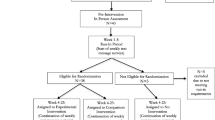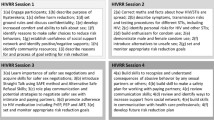Abstract
Female sex workers have been central in India’s HIV epidemic since it was first diagnosed among them in 1989. Female sex workers’ risk of HIV is primarily economically motivated. The Pi pilot study examined the feasibility and association of a microenterprise intervention, the tailoring of canvas bags, on sexual risk behaviors among female sex workers (N = 100) in Chennai. Women were randomized to an intervention or control arm. Between-group comparisons at baseline and at six-month follow-up were performed. Multivariate linear regression with bootstrapping was conducted to estimate the intervention effect. At baseline, women were a median of 35 years old, 61% were married and they had an average of two children. Intervention participants reported a significantly lower number of sex partners and significant increases in income at the 6-month follow-up compared to control participants. In a multivariate model, intervention participants had a significantly lower number of paying clients per month at follow-up compared to control participants. By graduation, 75% of intervention arm participants had made at least one sellable canvas bag and 6 months after the study’s end, 60% have continued involvement in bag production. The pilot study demonstrated that microenterprise interventions are successful in both providing FSWs with licit income opportunities and was associated with reductions in HIV risk behaviors.

Similar content being viewed by others
References
Organization NAC. HIV/AIDS: facts and figures. Available at: www.nacoonline.org. Accessed 30 Jan 2007.
Venkataramana C, Sarada P. Extent and speed of spread of HIV infection in India through the commercial sex networks: a perspective. Trop Med Int Health. 2001;6(12):1040–61.
Radhika Brahme M, Mehta S, Sahay S, et al. Correlates and trend of HIV prevalence among female sex workers attending sexually transmitted disease clinics in Pune, India (1993–2002). J Acquir Immune Defic Syndr. 2006;41(1):107–13.
Chandrasekaran P, Dallabetta G, Loo V, Rao S, Gayle H, Alexander A. Containing HIV/AIDS in India: the unfinished agenda. Lancet Inf Dis. 2006;6(8):508–21.
Nagelkerke N, Jha P, Vlas S, et al. Modelling HIV/AIDS epidemics in Botswana and India: impact of interventions to prevent transmission. Bull WHO. 2002;80(2):89–96.
Kim J, Watts C, Hargreaves J, et al. Understanding the impact of a microfinance-based intervention on women’s empowerment and the reduction of intimate partner violence in South Africa. Am J Public Health. 2007;97(10):1794–802.
Klein C, Easton D, Parker R, O’Leary A. Structural barriers and facilitators in HIV prevention: a review of international research. In: Beyond condoms: alternate approaches to HIV prevention. New York: Kluwer Academic Plenum Publishers; 2002: p. 14–46.
Farmer P, Connors M, Simons J. Women, poverty and AIDS: sex drugs and structural violence. Monroe, ME: Common Courage Press; 1996.
Dworkin S, Blankenship K. Microfinance and HIV/AIDS prevention: assessing its promise and limitations. AIDS Behav. 2009;13(3):462–9.
Greig F, Koopman C. Multilevel analysis of women’s empowerment and HIV prevention: quantitative survey results from a preliminary study in Botswana. AIDS Behav. 2003;7(2):195–208.
Sanders-Phillips K. Factors influencing HIV/AIDS in women of color. Public Health Rep. 2002;117(Suppl 1):S151–9.
Maman S, Mbwambo J, Hogan N, et al. HIV-positive women report more lifetime partner violence: findings from a voluntary counseling and testing clinic in Dar es Salaam, Tanzania. Am J Public Health. 2002;92(8):1331–7.
Exner T, Hoffman S, Dworkin S, Ehrhardt A. Beyond the male condom: the evolution of gender-specific HIV interventions for women. Annu Rev Sex Res. 2003;14:114–36.
Blankenship K, Bray S, Merson M. Structural interventions in public health. AIDS. 2000;14(Supp 1):S11–21.
Sumartojo E. Structural factors in HIV prevention: concepts, examples, and implications for research. AIDS. 2000;14(Supp 1):S3–14.
Buzdugan R, Halli SS, Cowan FM. The female sex work typology in India in the context of HIV/AIDS. Trop Med Int Health. 2009;14(6):673–87.
Kumar S. A rapid situation assessment of sexual risk behavior and substance use among sex workers and their clients in Chennai (Madras), South India. Geneva: World Health Organization; 2003.
Blankenship K, Friedman S, Dworkin S, Mantell J. Structural interventions: concepts, challenges and opportunities for research. J Urban Health. 2006;83(1):59–72.
Coates T, Richter L, Caceres C. Behavioural strategies to reduce HIV transmission: how to make them work better. Lancet. 2008;372(9639):669–84.
Gupta G, Parkhurst J, Ogden J, Aggleton P, Mahal A. Structural approaches to HIV prevention. Lancet. 2008;372(9640):764–75.
Shahmanesh M, Patel V, Mabey D, Cowan F. Effectiveness of interventions for the prevention of HIV and other sexually transmitted infections in female sex workers in resource poor setting: a systematic review. Trop Med Int Health. 2008;13(5):659–79.
Hanenberg R, Sokal D, Rojanapithayakorn W, Kunasol P. Impact of Thailand’s HIV-control programme as indicated by the decline of sexually transmitted diseases. Lancet. 1994;344(8917):243–5.
Rojanapithayakorn W, Hanenberg R. The 100% condom program in Thailand. AIDS. 1996;10(1):1–14.
Basu I, Jana S, Rotheram-Borus M, et al. HIV prevention among sex workers in India. JAIDS. 2004;36(3):845–52.
Stratford D, Mizuno Y, Williams K, Courtenay-Quirk C, O’Leary A. Addressing poverty as risk for disease: recommendations from CDC’s consultation on microenterprise as HIV prevention. Public Health Rep. 2008;123(1):9–20.
Hashemi S, Schuler S, Riley A. Rural credit programs and women’s empowerment in Bangladesh. World Dev. 1996;24(4):635–53.
Schuler S, Hashemi S, Riley A. The influence of women’s changing roles and status in Bangladesh’s fertility transition: evidence from a study of credit programs and contraceptive use. World Dev. 1997;25(4):563–75.
Pronyk P, Hargreaves J, Kim J, et al. Effect of a structural intervention for the prevention of intimate-partner violence and HIV in rural South Africa: a cluster randomised trial. Lancet. 2006;368(9551):1973–83.
Sherman S, German D, Cheng Y, Marks M, Bailey-Kloche M. The evaluation of the JEWEL project: an innovative economic enhancement and HIV prevention intervention study targeting drug using women involved in prostitution. AIDS Care. 2006;18(1):1–11.
NIMH Collaborative HIV/STD Prevention Trial Group. Sexually transmitted disease and HIV prevalence and risk factors in concentrated and generalized HIV epidemic settings. AIDS. 2007;21(Suppl 2):S81–90.
Sherman SG, Sutcliffe C, Srirojn B, Latkin CA, Aramratanna A, Celentano DD. Evaluation of a peer network intervention trial among young methamphetamine users in Chiang Mai, Thailand. Soc Sci Med. 2009;68(1):69–79.
Latkin CA, Sherman SG, Knowlton A. HIV prevention among drug users: outcome of a network-oriented peer outreach intervention. Health Psychol. 2003;22(4):332–9.
Efron BRT. Bootstrap methods for standard errors, confidence intervals, and other measures of statistical accuracy. Stat Sci. 1986;1(1):54–77.
Chandrasekaran P, Dallabetta G, Loo V, et al. Evaluation design for large-scale HIV prevention programmes: the case of Avahan, the India AIDS initiative. AIDS. 2008;22(Suppl 5):S1–15.
Acknowledgements
We would like to thank all of the women who participated in the study as well as the research staff. This research was support by NIMH grant U10MH061543.
Author information
Authors and Affiliations
Corresponding author
Rights and permissions
About this article
Cite this article
Sherman, S.G., Srikrishnan, A.K., Rivett, K.A. et al. Acceptability of a Microenterprise Intervention Among Female Sex Workers in Chennai, India. AIDS Behav 14, 649–657 (2010). https://doi.org/10.1007/s10461-010-9686-z
Published:
Issue Date:
DOI: https://doi.org/10.1007/s10461-010-9686-z




